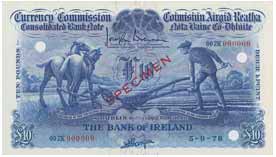
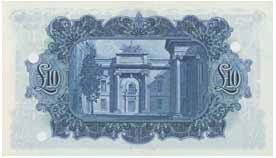
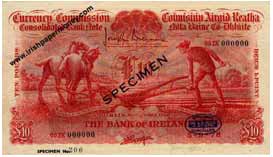
The Central Bank of Ireland Archive, first opened in 2017 to public access, has been a new source of data and information on the Consolidated Bank Notes. The archive is referenced as CBIAR in the text.
The Ploughman Scan Survey (PSS) is a detailed recording of the numbers and grades of the surviving Ploughman notes which has been underway for over 15 years. PSS has lead to a solid data set of 3,902 notes recorded, of which 337 are £10 notes. This is greater than 20% of all the £10 notes still outstanding.
Updated and additions to the numbers of surviving Ploughman Ten Pound notes are added periodically in the Ploughman Note Population Report.
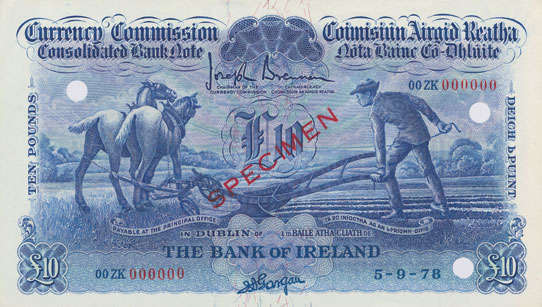
![]()
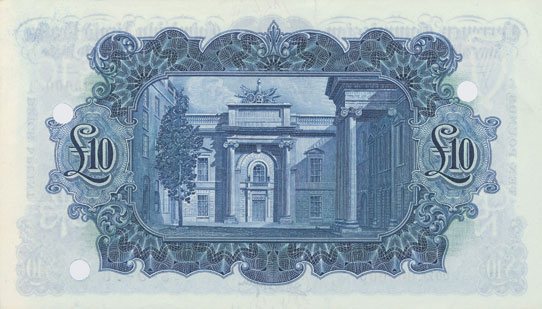
The Consolidted banknotes were designed by Irish artist Dermod O'Brien (1865-1945) [1.].
The Ten Pound Consolidated Bank Note is predominantly blue in colour, with a light green and multicoloured underprint. This is very similar to the colours used for the 'Lady Lavery' series Ten Pound Legal Tender Notes which were first issued in 1928.
The uniformity of the two parallel Currency Commission banknote issues was a contrast to the older Irish note issues of the commercial banks which were of a wide variety of designs. The Legal Tender and Consolidated Bank Note issues were to replace all of these.
The text on the face of the banknote is bilingual, with English language on the left side and in Irish on the right. This mirrors the Legal Tender Notes.
The first text at the top of the notes is the issuing authority title in an ornate style: 'Currency Commission Consolidated Bank Note', 'Coimisiún Airgid Reatha Nóta Bainc Có-Dhlúite'.
The primary signature of Joseph Brennan [3.] is printed in the centre at the top of each note, with his title below it in smaller letters: 'Chairman of the Currency Commission', 'Cathaoirleach Choimisiúin an Airgid Reatha'.
The denomination in words is printed discretely sideways on either side, 'Ten Pounds' in English on the left, 'Deich bPuint' on the right in Irish.
In considerably smaller text at the bottom of the note is printed 'Payable at the Principle Office in Dublin of', 'Tá so iníoctha ag an bPríomh-Oifig i mBaile Átha Cliath de'.
The name of one of the Associated Banks, the eight commercial banks operating in the Irish Free State which had the right to issue Consolidated Bank Notes, was printed below the 'payable at' text in a separate printing which was added along with the prefix of each banknote. The bank signatory was added below the bank title in the same printing as the prefix which was specific to each bank.
Apart from the official specimen notes printed in blue, examples of the Ten Pound notes are known as De La Rue printers specimens which were printed in red. These were for use in commercial specimen books. Also proofs and colour trials without a bank title were printed in various colours.
Illustrated below is an example of a red Bank of Ireland De La Rue Ploughman specimen Ten Pound note. These were printed on paper without watermarks. Also illustrated is an early proof.
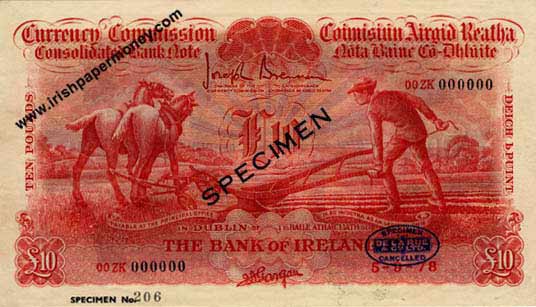
![]()
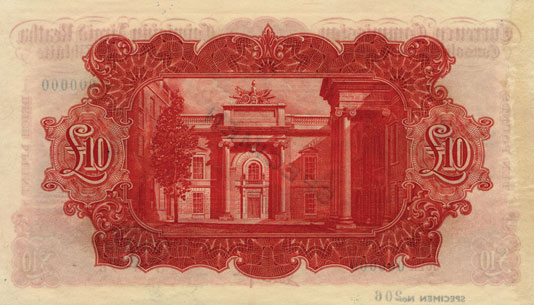
![]()

A Ten Pound De La Rue printer's specimen, above, and below a proof printed without bank title or serial numbers
Illustrated below is a partially printed proof. The underprint is fully printed, showing the knock outs left for the printing of the ploughman and horses.
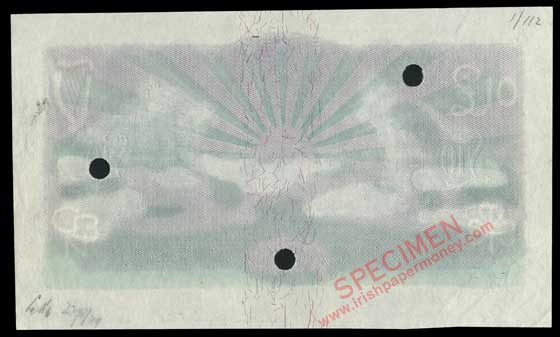
A partial proof of a Ploughman 10 Pound note, with underprint complete. It shows the knock out left for the second printing of the ploughman and horses [4. Spink, 2017]
The entrance to the Currency Commission building in Foster Place Dublin [5.] is featured on the reverse of the Ploughman Ten Pound note. the building was designed by Francis Johnston (1760-1829) [6.] and constructed in 1811. Johnston also designed other buildings in Dublin, notably the General Post Office in O'Connell Street, Dublin.
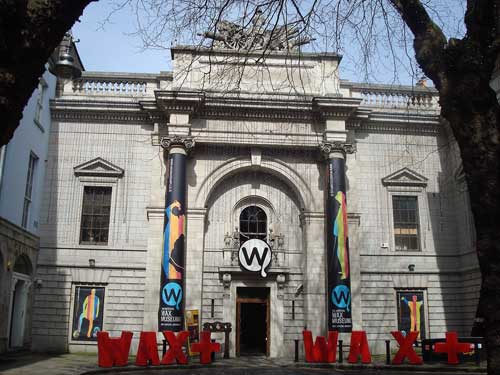
Entrance to the Currency Commission building, foster Place, Dublin in 2010. [5. Image source: DubhEire.]
The dimensions of the Consolidated Ten Pound notes are the same as those of the Ten Pound Legal Tender Notes, and are 191 x 108 mm. This can vary by up to 1 or 2 mm in either dimension.
Below are illustrated examples of the first date of a Ploughman Ten Pound note, 6.5.29, and the last date, 9.8.39. An image of every recorded date is on the Ploughman Note Dates page.

![]()
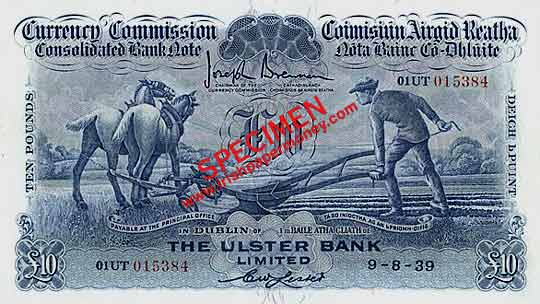
Ploughman Ten Pound notes were printed in several passes, starting with a multicolored underprint with knock outs leaving space for a heavier second print run. The top printing layer was then of raised intaglio printing which would have been difficult for forgers to reproduce effectively.
The title of the Issuing Authority text on top 'Currency Commission Consolidated Bank Note' 'Coimisiún Airgid Reatha Nóta Bainc Có-Dhlúite' and the signature 'Joseph Brennan' are printed in raised intaglio print which can be easily felt under one's finger, even when the note is well circulated.
In addition to the intaglio printing, the one pound Ploughman notes had a strip of multicolored fibbers embedded in the paper which ran down the centre of each note.
This was a common security feature of the time which was used on banknotes of some other countries such as China. The Watermarks and fibre strip are visible in the Portals sample paper, pictured below.
The Ploughman one pound notes were printed by Thomas De La Rue Limited on watermarked paper which was manufactured by Portals Limited.
There are four watermarks on the Consolidated One Pound note, one in each corner.
In designing the notes, it was considered that a watermark in the heavily printed centre of the note might be difficult to see. This can be the case with the central LTN watermark on the legal tender Lady Lavery banknotes.
Viewed from the face of the note, the watermarks on the Ploughman one pound note are a harp on the left, '£1' on the right, the letters 'CBN' (Consolidated Bank Note) on the bottom left, and a shamrock on the bottom right. The £1 watermark is specific to the Ploughman One Pound note denomination.

The four watermarks on the Ploughman Ten Pound note are easily visible on this sample of the watermarked paper from the archive of the manufacturers, Portals

The four individual watermarks on the Ten Pound Ploughman note are easily visible in each corner when the note is viewed from the reverse side
The Currency Commission 'Ploughman' Ten Pound note is a relatively common denomination of the attractively designed Consolidated Bank Note series.
During the Irish Free State era Consolidated Bank Notes circulated alongside the 'Lady Lavery' Legal Tender Notes in modest quantities. First issued in 1929, Consolidated £10 notes were issued in large quantities and saw wide usage, though they were always much less common than their Legal Tender Note counterparts. They continued to be accepted in occasional circulation right up to the end of the 1960s, and are exchangeable at their face value without time limit. The numismatic value of a Ploughman 10 Pound note in any grade far exceeds its face value.
All eight Associated Banks made considerable usage of the Ten Pound Consolidated Bank Notes, with the Munster and Leinster Bank and National Bank being the largest issuers. £10 notes of these two banks account for slightly over 50% of the total number of surviving £10 Ploughman notes recorded in the Consolidated Bank Note Population Report.
Examples of 10 Pound Ploughman notes from the Northern Bank are by far the scarcest with just seven examples of the note recorded in the Ploughman Population Report.
By far, the rarest Ploughman Ten Pound note by signature is the Provincial Bank of Ireland Ten Pounds Ploughman signed Kennedy, with just three examples recorded in the Population Report. The first example of a Kennedy Ploughman Ten Pound note was recorded in the early 1990s.
Generally 1929 is the most common year for the Ploughman 10 Pound notes of all the banks. Three banks, Bank of Ireland, Royal Bank of Ireland, Northern Bank, issued only the first date, 6 May 1929
None of the banks came close to using up the first prefix, 01, for their £10 notes. The highest observed prefix for a Ploughman 10 Pound note in the Ploughman Scan Survey is 01MT 086993, Munster & Leinster Bank. The second highest issued note recorded for a bank is 01NT 051444, National Bank.
Relatively few of the Ploughman 10 Pound notes which were printed remained unissued by the termination of the Consolidated Bank Note issue in 1942. Of the 22 dates for the Ploughman 10 Pound note three have never been recorded, two of these from the National Bank, and one from the Hibernian Bank.
When the Currency Commission Ireland was wound up and replaced by the Central Bank of Ireland, Ploughman Ten Pound notes ceased to be produced. The notes continued to be issued and redeemed by the banks past this era.
On 31 December 1953 all issues ceased, and the Central Bank of Ireland became the sole issuer of banknotes in Ireland.
Ploughman 10 Pound notes are quite common. It is relatively to obtain a presentable example issued by the National Bank or Munster & Leinster Bank without much difficulty. They are regularly offered in sales.
Data from the Ploughman note Population Report, based on the Ploughman Scan Survey, reveals the relative rarity of the banks with respect to each other for Ploughman Ten Pound notes:
Munster & Leinster Bank (31.8%), National Bank (19.3%), Provincial Bank of Ireland (18.1%), Hibernian Bank (10%), Bank of Ireland (6.6%), Ulster Bank (6.2%), Royal Bank of Ireland (6%), Northern Bank (2%).
It is noteworthy that Bank of Ireland £10 Ploughman notes are of a similar scarcity as those of the Royal Bank of Ireland and Ulster Bank, both of which were much smaller overall issuers of Ploughman notes. Although by far the largest bank in terms of the size of its note issue, Bank of Ireland issued very few Ploughman £10 notes. The relative rairty of the Bank of Ireland Ploughman 10 Pound note is not always reflected in sales.
Examples of high grade notes, EF region or better, are known for Ploughman 10 Pound notes from all the banks except the Northern Bank. The highest grade Northern Bank £10 Pound note recorded in PSS is VF.
Below is an example of a Ploughman 10 Pound note issued by each of the eight banks.

![]()
![]()

![]()

![]()

![]()

![]()
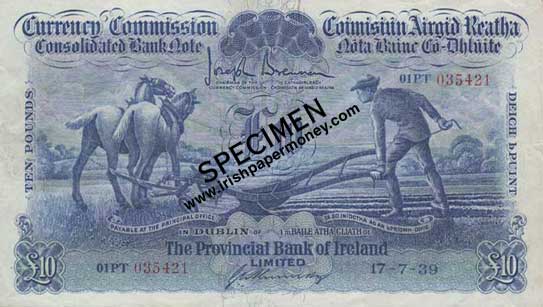
![]()
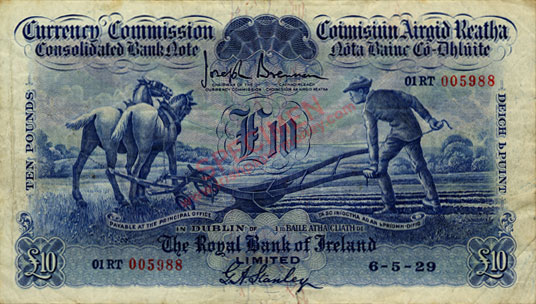
![]()

There are 12 signature varieties among the eight banks for the £10 Consolidated Bank Note. Of these, two are rare: Northern Bank 10 Pound, 1929, with Knox signature, with only seven examples recorded in the Consolidated Bank Note Population Report; and Provincial Bank of Ireland, 1939, with Kennedy signature, with just three notes recorded.
Examples of all of the other 10 signatures would be relatively easy to obtain.
Bank of Ireland: Gargan 1929.
Hibernian Bank: Campbell 1929-1939.
Munster & Leinster Bank: Gubbins 1929-1931, Hosford 1938-1939.
National Bank: Russell 1929-1939.
Northern Bank: Knox 1929.
Provincial Bank of Ireland: Robertson 1929, Fforde 1931, Kennedy 1939.
Royal Bank of Ireland: Stanley 1929.
Ulster Bank: Patton 1929, Lester 1938-1939.
References [Last retrieved 14.08.24]
1. Central Bank of Ireland Archives.
2. Dermod O'Brien (1865-1945) < https://www.dib.ie/biography/obrien-dermod-a6460p >
3. Joseph Brennan (1887-1976) < https://www.dib.ie/biography/brennan-joseph-a0938 >
4. Spink Auctions, London, 2017. < https://www.spink.com >
5. Former Currency Commission building, Foster Place. Source: DubhEire via < https://commons.wikimedia.org/wiki/File:The_National_Wax_Museum_Plus,_The_Armoury,_Foster_Place,_Temple_Bar,_Dublin.JPG
6. Francis Johnston (1760-1829) < https://www.dia.ie/architects/view/2833 >
1 Pound Ploughman
5 Pounds Ploughman
10 Pounds Ploughman
20 Pounds Ploughman
50 Pounds Ploughman
100 Pounds Ploughman
Irish Ten Shilling Notes
1 Pound Note Lady Lavery
5 Pounds Lady Lavery
10 Pounds Lady Lavery
20 Pounds Lady Lavery
50 Pounds Lady Lavery
100 Pounds Lady Lavery
1 Pound Note, Queen Medb
5 Pound Note, John Scotus Eriugena
10 Pound Note, Jonathan Swift
20 Pound Note, W. B. Yeats
50 Pound Note, Turlough O'Carolan
100 Pound Note, Grace O'Malley
5 Pound Note, Sister Catherine McAuley
10 Pound Note, James Joyce
20 Pound Note, Daniel O'Connell
50 Pound Note, Douglas Hyde
100 Pound Note, Charles Stewart Parnell
Northen Ireland Polymer notes
Bank of Ireland Polymer Notes
Danske Bank Polymer Notes
Ulster Bank Polymer Notes
Special Sections and Articles
The Transition of Irish Currency, Irish banknotes 1918–1928
The Partition of Irish Currency, Irish banknotes 1928–1930
Banknote Design Evolution 1824 to 1916
Irish Three Pound Notes
Contemporary Forgeries of Early Irish Banknotes, ca1800-1930
Limerick Soviet Notes
Irish World War 2 Banknote Issues
Low Number Irish Banknotes
Irish Joint Stock Banks of Note Issue from 1783
Irish Legal Tender Note Specimens
Ploughman Scan Survey (PSS)
![]() Stable version. Last update 24.08.24.
Stable version. Last update 24.08.24.